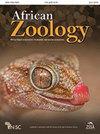Distribution and Abundance of African Elephants in Ngorongoro Crater, Northern Tanzania
IF 0.5
4区 生物学
Q4 ZOOLOGY
引用次数: 0
Abstract
We studied the distribution and abundance of African elephants in Ngorongoro Crater (NC), northern Tanzania to test whether male and female elephants select different habitats and to assess whether elephant abundance was related to monthly precipitation. From 2016 to 2017, we conducted thirteen total counts in the dry and wet seasons and collected data on elephant age, sex, social structure, and habitat use. Most elephants encountered in NC were male-only groups (70%). Elephant numbers were significantly greater in the wet season, compared with the dry season evidenced by a significant and positive linear relationship between elephant abundance and monthly rainfall. Elephants in the NC showed distinct sex segregation, with males preferring open habitats (swamps and grasslands) and female groups preferring closed habitats (bush-shrubland and Vachellia xanthophloea woodland). This study advances our understanding of elephant grouping patterns and sex-specific habitat usage in savannah ecosystems.坦桑尼亚北部恩戈罗恩戈罗火山口非洲象的分布和数量
我们研究了坦桑尼亚北部恩戈罗恩戈罗火山口(Ngorongoro Crater, NC)非洲象的分布和丰度,以测试雄性和雌性大象是否选择不同的栖息地,并评估大象丰度是否与月降水量有关。从2016年到2017年,我们在干湿季节共进行了13次计数,收集了大象年龄、性别、社会结构和栖息地使用的数据。在北卡罗来纳遇到的大多数大象都是雄性群体(70%)。与旱季相比,雨季大象数量显著增加,这表明大象数量与月降雨量之间存在显著的正线性关系。北洋象表现出明显的性别隔离,雄性偏好开放栖息地(沼泽和草原),而雌性偏好封闭栖息地(灌木林地和黄叶阔叶树林地)。这项研究促进了我们对草原生态系统中大象类群模式和性别特异性栖息地利用的理解。
本文章由计算机程序翻译,如有差异,请以英文原文为准。
求助全文
约1分钟内获得全文
求助全文
来源期刊

African Zoology
生物-动物学
CiteScore
2.60
自引率
9.10%
发文量
18
审稿时长
>12 weeks
期刊介绍:
African Zoology , a peer-reviewed research journal, publishes original scientific contributions and critical reviews that focus principally on African fauna in terrestrial, freshwater, and marine ecosystems. Research from other regions that advances practical and theoretical aspects of zoology will be considered. Rigorous question-driven research in all aspects of zoology will take precedence over descriptive research. The Journal publishes full-length papers, critical reviews, short communications, letters to the editors as well as book reviews. Contributions based on purely observational, descriptive or anecdotal data will not be considered.
The Journal is produced by NISC in association with the Zoological Society of South Africa (ZSSA). Acceptance of papers is the responsibility of the Editors-in-Chief in consultation with the Editors and members of the Editorial Advisory Board. All views expressed are those of the author and not necessarily those of the Editors or the Department.
 求助内容:
求助内容: 应助结果提醒方式:
应助结果提醒方式:


